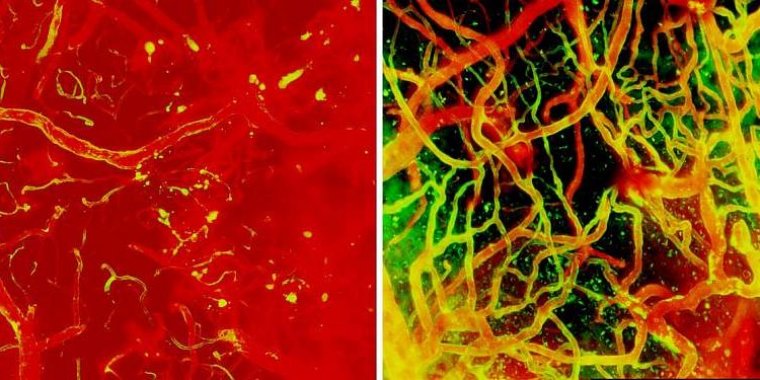| Health / Health News |
Timing is of the essence when treating brain swelling in mice
Researchers from the National Institutes of Health have discovered Jekyll and Hyde immune cells in the brain that ultimately help with brain repair but early after injury can lead to fatal swelling, suggesting that timing may be critical when administering treatment. These dual-purpose cells, which are called myelomonocytic cells and which are carried to the brain by the blood, are just one type of brain immune cell that NIH researchers tracked, watching in real-time as the brain repaired itself after injury.

At day 1 after injury (left panel), the brain had areas of bleeding and broken vessels. Ten days later (right panel) the vessels were almost completely rebuilt. Photo: McGavern Lab/NINDS
“Fixing the brain after injury is a highly orchestrated, coordinated process, and giving a treatment at the wrong time could end up doing more harm than good,” said Dorian McGavern, Ph.D., NINDS scientist and senior author of the study.
Cerebrovascular injury, or damage to brain blood vessels, can occur following several conditions including traumatic brain injury or stroke. Dr. McGavern, along with Larry Latour, M.D., NINDS scientist, and their colleagues, observed that a subset of stroke patients developed bleeding and swelling in the brain after surgical removal of the blood vessel clot responsible for the stroke.
The swelling, also known as edema, results in poor outcomes and can even be fatal as brain structures become compressed and further damaged.
Immediately after injury, brain immune cells known as microglia quickly mobilize to stop blood vessels from leaking. These “first responders” of the immune system extend out and wrap their arms around broken blood vessels. Dr. McGavern’s group discovered that removing microglia causes irreparable bleeding and damage in the brain.
A few hours later, the damaged brain is invaded by circulating peripheral monocytes and neutrophils (or, myelomonocytic cells). As myelomonocytic cells move from the blood into the brain, they each open a small hole in the vasculature, causing a mist of fluid to enter the brain. When thousands of these cells rush into the brain simultaneously, a lot of fluid comes in all at once and results in swelling.
“The myelomonocytic cells at this stage of repair mean well, and do want to help, but they enter the brain with too much enthusiasm. This can lead to devastating tissue damage and swelling, especially if it occurs around the brain stem, which controls vital functions such as breathing,” said Dr. McGavern.
After this initial surge, the monocytic subset of immune cells enter the brain at a slower, less damaging rate and get to work repairing the vessels. Monocytes work together with repair-associated microglia to rebuild the damaged vascular network, which is reconnected within 10 days of injury. The monocytes are required for this important repair process.
In the next set of experiments, Dr. McGavern and his colleagues tried to reduce secondary swelling and tissue damage by using a combination of therapeutic antibodies that stop myelomonocytic cells from entering the brain.
The antibodies blocked two different adhesion molecules that myelomonocytic cells use to attach to inflamed blood vessels. These were effective at reducing brain swelling and improving outcomes when administered within six hours of injury.
Interestingly, the therapeutic antibodies did not work if given after six hours or if they were given for too long. In fact, treating mice over a series of days with these antibodies inhibited the proper repair of damaged blood vessels, leading to neuronal death and brain scarring. (National Institutes of Health)
YOU MAY ALSO LIKE





